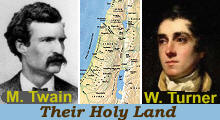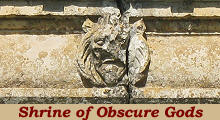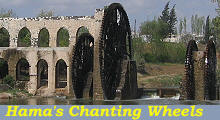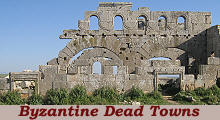  What's New! Detailed Sitemap All images © by Roberto Piperno, owner of the domain. Write to romapip@quipo.it. Text edited by Rosamie Moore. Page added in May 2013. |
  - Jerusalem - The Four Quarters - Jerusalem - The Four Quarters
If you came to this page directly, you might wish to read a page with an introduction to this section first or start with Jerusalem - The Walls.
Lepers, cripples, the blind, and the idiotic, assail you on every hand, and they know but one word of but one language apparently - the eternal "bucksheesh" (an alm, a tip or a small bribe). To see the numbers of maimed, malformed and diseased humanity that throng the holy places and obstruct the gates, one might suppose that the ancient days had come again, and that the angel of the Lord was expected to descend at any moment to stir the waters of Bethesda. Mark Twain - The Pilgrims Abroad - 1869 If Twain visited Jerusalem today he would be glad to see that there are no beggars and that its inhabitants are not in particularly poor health.
There are three small streets of Bezesteins (bedesten, a Turkish word meaning covered market) arched, but narrow, dark and dirty. In these stuffs are sold and there are many silversmiths who work coffee cups and chalices for the convents. The bazaars are mean and ill provided. We met a Turk walking through the bazaars this evening entirely naked. On inquiry I was told he is or pretends to be mad and in consequence is esteemed by the Turks as a saint. William Turner - Journal of a Tour in the Levant - 1820. Almost half of the Old City is a marketplace. The shops of Via Dolorosa in the Muslim Quarter cater for Christian pilgrims, but the other shops of the quarter are not tourist oriented. Their customers come from the eastern and northern suburbs of Jerusalem, where most of the Arab population lives.
The streets are roughly and badly paved with stone, and are tolerably crooked - enough so to make each street appear to close together constantly and come to an end about a hundred yards ahead of a pilgrim as long as he chooses to walk in it. M. Twain Bethesda is almost the only remaining residential quarter inside the Old City and it has retained the appearance it had when Twain visited Jerusalem. The quarter is quoted in John 5:2: Now there is at Jerusalem by the sheep market a pool, which is called in the Hebrew tongue Bethesda, having five porches. The pool was a large ancient cistern.
Without the convents Jerusalem would be nearly a desert. There are a few good houses built of the large materials of the ruins and mostly possessed by the Turks; but the generality, though all stone, bear a wretched appearance. W. Turner Turner, who had not visited Damascus, Aleppo or Cairo before Jerusalem was not familiar with Mameluke architecture (Twain could not care less about it). Unfortunately the high portals of most buildings cannot be properly appreciated because of the narrowness of the streets.
The main buildings of Mameluke Jerusalem were built along Silsileh Street at the southern end of the Muslim Quarter where it borders on the Jewish one. The street was named after a gate leading to Qubbet el-Silsileh (Dome of the Chain). The image used as background for this page shows a typical Mameluke decorative pattern.
Ottoman Sultan Suleyman I improved the water supply system of Jerusalem and he built a net of fountains. They are called sabil (or sebil), a word which the Turks used for kiosks where passers-by were offered glasses of water, whereas public fountains were called cesme (you may wish to see a sebil and a cesme at Constantinople).
The finest fountains were built near the gates of Haram esh-Sheriff, the complex of Muslim religious buildings on the terrace of the Temple. Today these fountains are located at a critical checkpoint between the Muslim Quarter and the Wailing Wall.
Some decorative elements of the Ottoman fountains were taken from ancient buildings. Some monuments of the Muslim Quarter have been restored, but overall it is fair to say that non-Jewish heritage monuments of Jerusalem are children of a lesser god.
I dined and supped with Padre Clemente Perez the "procuratore curatore" of the convent who has two very good apartments. He tells me that the convent contains now thirty three monks and formerly had above sixty and that it gives bread weekly to above 800 Christians and to some Turks. That the convent also gives linen for making shirts and cloth for dresses. The petitioners have some two loaves a week, some one, some half a one, according to their necessities and merits. This has been always continued in spite of the poverty of the convent so that it is now considerably indebted. W. Turner The Ottoman Empire dealt with the plurality of religions of its population by recognizing four millets (confessional communities) for its Muslim, Greek Orthodox, Armenian and Jewish subjects. Family law was administered by religious courts; the appointment of millet leaders was endorsed by the Sultan. The four communities lived in separate quarters. In some Greek towns Muslim and Jews lived within the walls and the Greek Orthodox outside them (e.g. at Rhodes). At Jerusalem each of the four millet had its own quarter. Roman Catholics were not allowed to have a millet and a quarter of their own, but the King of France was recognized by the Sultan as their Protector. The Franciscans were acknowledged a special authority in the Holy Land and part of the Christian Quarter in Jerusalem belonged to them.
The Christian Quarter was largely renovated in the late XIXth century when many new churches and hospitals were built. In 1869 a large area, which included a hospital (Muristan) which was going to rack and ruin, was donated by Ottoman authorities to the King of Prussia and to the Greek Orthodox Patriarchate. The name continues to indicate the area after it has been turned into a modern shopping district surrounding the only public square and European-style fountain of Jerusalem.
During the 1948 War the Jews who lived in the Old City had to abandon their homes. The Jordanian troops pillaged and burnt the synagogues as well as many other buildings of the Jewish Quarter. Hurva was the most imposing synagogue; it was built in the XIXth century at a time when the Ottomans allowed the construction of synagogues and churches of large size. It was rebuilt in 2010 and its almost Ottoman dome has become a landmark of the Old City. Some small synagogues which were pillaged in 1948 have been refurbished with altars and cupboards coming from closed synagogues of the Jewish Diaspora.
We walked to the Armenian convent, the largest in Jerusalem. It is said to contain 350 chambers which in the time of the Frank kings of the Holy Land I was told was an hospital. We found many pilgrims lounging about the door for all who can pay lodge in the convents and on the outside was a crowded bazaar of beads, crucifixes, etc. In this church which is built on part of Mount Sion is said to be the spot where St. James (the Greater) was beheaded. W. Turner The Armenian Quarter, the smallest one, is situated in the south-western corner of the Old City in a rather secluded area with no large streets crossing it. See these other pages on Jerusalem
Move to: Introductory Page Nimrod Castle Banias (Caesarea Philippi) Acre (Akko) Turner's excursion to Kaifah (Haifa) Tiberias Holy sites in Galilee Nazareth Jaffa A Glimpse of Tel Aviv     |











